Forget about washing the car. It’s raining Sahara sand again…
Thursday, July 28, 2016
 It hadn't rained since late April. The fields were brown sticks and the soil ravaged and bone dry. If we were to believe Antonio, the 85-year-old farmer up the street, and we always do, it would not rain until November. The heat was stifling day as well as night. Occasionally, we would have a few days of wind, which gave the females in the neighbourhood migraines, though to me it was a welcome repose. At least the hot air got blown past one, instead of drowning one in stillness. It hadn't rained since late April. The fields were brown sticks and the soil ravaged and bone dry. If we were to believe Antonio, the 85-year-old farmer up the street, and we always do, it would not rain until November. The heat was stifling day as well as night. Occasionally, we would have a few days of wind, which gave the females in the neighbourhood migraines, though to me it was a welcome repose. At least the hot air got blown past one, instead of drowning one in stillness.
One day we woke up to a bizarre sky, as if we were looking at it though unpolished glasses. Something was definitively up. We heard a plop, then another and several more. ”Could it be rain?” we thought. Hurrying to the terrace, I felt something on my skin. Not actual rain drops, but gritty warmish globs of red mud. The ‘rain’ only lasted a few minutes. Then it got dead quiet, leaving a world covered in fine rust-coloured dust, everywhere, in every indentation and on every surface. The cars parked on the street had a film of dust and in some places a mini-reef of fine-grained sand. Our neighbour shrugged his shoulders. “It’s lluvia de barro (mud rain) from Sahara.,” he told us, as if it was the most natural thing in the world. And apparently it is. Thankfully not a daily occurrence, African mud rain is quite common in the Mediterranean region. However, with the right atmospheric circumstances, Saharan sand has been registered as far away as my own Scandinavia, southern USA and even South East Asia. We are talking thousands of miles! Not shabby for plain old dust….
 Sometimes called lluvia de sange (blood rains) because of the dust particles’ particular tone of red, Sahara Rains actually happen all year around, though it is certainly more noticeable here during the dry summer months. Strong winds originating in the Sahara desert get transported beyond the African continent, where later precipitation rinses the dust out of the atmosphere, bringing it down in the form of muddy drops. For the phenomenon to take place it allegedly needs several atmospheric conditions to be present simultaneously. First, it needs a prolonged period of draught in the Sahara region (isn't it always?), which produces an increased presence of suspended dust. Secondly, it needs the above-mentioned particles to get into the higher layers of the atmosphere, more specifically for us in Spain, with a southern or South Eastern wind. Finally, it needs precipitation in the area of the dust recipients. Sometimes called lluvia de sange (blood rains) because of the dust particles’ particular tone of red, Sahara Rains actually happen all year around, though it is certainly more noticeable here during the dry summer months. Strong winds originating in the Sahara desert get transported beyond the African continent, where later precipitation rinses the dust out of the atmosphere, bringing it down in the form of muddy drops. For the phenomenon to take place it allegedly needs several atmospheric conditions to be present simultaneously. First, it needs a prolonged period of draught in the Sahara region (isn't it always?), which produces an increased presence of suspended dust. Secondly, it needs the above-mentioned particles to get into the higher layers of the atmosphere, more specifically for us in Spain, with a southern or South Eastern wind. Finally, it needs precipitation in the area of the dust recipients.
One recognizes an incoming cloudburst of Saharan dust by watching the sky, which takes on an unusual muddy colour and dense luminosity. Other than the fact that it obscures the sky, such amounts of airborne smut are obviously not comfortable, nor healthy to inhale or ingest. Especially people with respiratory problems and asthma (popularly called ‘ama’ in Andalucía, for those who may wonder) ought to stay indoors and not engage in anything that may cause physical exertion. Yet, contrary to what this may make one believe, Saharan rain has nothing to do with pollution per se. With acid rain the opposite atmospheric phenomenon occurs, when the absence of wind allows the pollution on the earth’s surface to rise into the atmosphere, not the presence of it.
 Once you know what on earth the blood rains are, it is no longer very exciting. In fact it is a royal pain in the you-know-what. The fine sand particles adhere to anything and are virtually impossible to extract. You have to hose down your terraces and walls at least twice, especially if you live in a Pueblo Blanco (white village) like we do. The dust seems particularly attracted to shiny surfaces, so beware that your car will get a good sandblasting. It will appear in the most hidden away places, being brought along by the aid of mysterious, invisible currents. Months later, when you think you have gotten all the traveling dust out of your car, and your life, you will open your trunk and find the rusty particles lining the entire inner door jam system, where seemingly not even air can get to. Once you know what on earth the blood rains are, it is no longer very exciting. In fact it is a royal pain in the you-know-what. The fine sand particles adhere to anything and are virtually impossible to extract. You have to hose down your terraces and walls at least twice, especially if you live in a Pueblo Blanco (white village) like we do. The dust seems particularly attracted to shiny surfaces, so beware that your car will get a good sandblasting. It will appear in the most hidden away places, being brought along by the aid of mysterious, invisible currents. Months later, when you think you have gotten all the traveling dust out of your car, and your life, you will open your trunk and find the rusty particles lining the entire inner door jam system, where seemingly not even air can get to.
Having fiercely vacuumed out the very last particle of the blasted hidden dust and given the car an almost professional detailing in the process, you sense a weather change coming. You look back up at the sky, noticing that it has taken on a curiously red colour…

 3
Like
Published at 6:20 PM Comments (1)
3
Like
Published at 6:20 PM Comments (1)
Walking on air – the deadly Caminito del Rey has become a walk in the park
Friday, July 22, 2016
 The world is full of daredevils who will sink their grimy nails into any piece of vertical rock, with or without safety. El Caminito used to be one of the places where human spiders with suction cups for hands used to convene to dare each other into virtually walking on air. Some did it, their hair-raising videos going instantly viral, while others were not so lucky, ending their climbing careers and lives at the bottom of the gorge. Andalucía’s Caminito del Rey (The King’s Little Pathway) reopened after major reconstructions last year. It is still a spectacular and thrilling experience to most. What used to be known as the world’s most dangerous boardwalk is now literally a walk in the park. The world is full of daredevils who will sink their grimy nails into any piece of vertical rock, with or without safety. El Caminito used to be one of the places where human spiders with suction cups for hands used to convene to dare each other into virtually walking on air. Some did it, their hair-raising videos going instantly viral, while others were not so lucky, ending their climbing careers and lives at the bottom of the gorge. Andalucía’s Caminito del Rey (The King’s Little Pathway) reopened after major reconstructions last year. It is still a spectacular and thrilling experience to most. What used to be known as the world’s most dangerous boardwalk is now literally a walk in the park.
 El Chorro lies about 45 minutes inland from Malaga off the Campillos road, near the town of Ardales. The breath-taking three-kilometre Gaitanes gorge, at some points only 10 meters wide and 700 meters deep, was carved into the limestone and dolomite cliffs by the Guadalhorce river. It was not until the 1860’s that the canyon gained importance, when the Málaga-Córdoba railway was constructed along 17 tunnels, 8 viaducts and 18 bridges with the most spectacular part going through El Chorro gorge. (The railway is still open today and is absolutely worth the trip.) El Chorro lies about 45 minutes inland from Malaga off the Campillos road, near the town of Ardales. The breath-taking three-kilometre Gaitanes gorge, at some points only 10 meters wide and 700 meters deep, was carved into the limestone and dolomite cliffs by the Guadalhorce river. It was not until the 1860’s that the canyon gained importance, when the Málaga-Córdoba railway was constructed along 17 tunnels, 8 viaducts and 18 bridges with the most spectacular part going through El Chorro gorge. (The railway is still open today and is absolutely worth the trip.)
 In the early 20 Century, hydroelectric power plants and dams were built on either end of the gorge to provide electricity to the area. The original walkway, built between 1901 and 1905, was constructed to give the workers a means to move between the plants. The one-meter-wide steel enforced concrete walkway was built into the rock face on the opposite side to the railway about 100 metres above the river. It was crossed by Spain’s King Alfonso XII in 1921 and have carried his name ever since. In the early 20 Century, hydroelectric power plants and dams were built on either end of the gorge to provide electricity to the area. The original walkway, built between 1901 and 1905, was constructed to give the workers a means to move between the plants. The one-meter-wide steel enforced concrete walkway was built into the rock face on the opposite side to the railway about 100 metres above the river. It was crossed by Spain’s King Alfonso XII in 1921 and have carried his name ever since.
 As years passed and roads became a faster way to get between the dams, the walkway fell into disrepair. The original handrails gradually fell off and in many sections the concrete top collapsed, leaving gaps bridged only by rusty, narrow steel beams. These open-air gaps were exactly what attracted the climbers to the place. The local authorities tried to discourage use, removing entire pieces of the path at the entrances to make it ‘impossible’ to get onto it. Of course, the more difficult they made it, the more attractive it became to climbers. The authorities closed the path to the public in year 2000 after several people lost their lives there. Even after the closing, four other climbers died attempting to cross the gorge. As years passed and roads became a faster way to get between the dams, the walkway fell into disrepair. The original handrails gradually fell off and in many sections the concrete top collapsed, leaving gaps bridged only by rusty, narrow steel beams. These open-air gaps were exactly what attracted the climbers to the place. The local authorities tried to discourage use, removing entire pieces of the path at the entrances to make it ‘impossible’ to get onto it. Of course, the more difficult they made it, the more attractive it became to climbers. The authorities closed the path to the public in year 2000 after several people lost their lives there. Even after the closing, four other climbers died attempting to cross the gorge.
 With such a dark history, it is strange that any of us mere mortals would even dream of venturing onto the path. Yet, El Caminito del Rey was listed as Lonely Planet’s ‘best new attractions’ in 2015 and the reconstruction received EU’s Nostra Award and Grant Prix for Cultural Heritage Sites and various other awards. To me, it is a great marriage between an alpinists dream, safe engineering and sleek aesthetical adaption to the landscape. Of course without the dangling off a cliff thrill, daredevils now must go elsewhere. With such a dark history, it is strange that any of us mere mortals would even dream of venturing onto the path. Yet, El Caminito del Rey was listed as Lonely Planet’s ‘best new attractions’ in 2015 and the reconstruction received EU’s Nostra Award and Grant Prix for Cultural Heritage Sites and various other awards. To me, it is a great marriage between an alpinists dream, safe engineering and sleek aesthetical adaption to the landscape. Of course without the dangling off a cliff thrill, daredevils now must go elsewhere.
 My husband and I had heard about El Chorro prior to moving to Spain, but as neither of us was inclined to throw ourselves off cliffs, we, as many, excitedly awaited the opening of the refurbished boardwalk, which after many delays happened in March 2015. As soon as we heard, we made a booking. When we went one could walk in either direction, so we left and came back to the same point to see the gorge twice. Now all entrances are from Ardales, with a bus service taking one back. Actually, this is the best way to see the gorge anyhow, as you start out less steep and save the most spectacular (and to some maybe the most scary…) parts to the very end. The roads to get there are narrow and winding, so take it easy and do not have too many beers at the charming restaurant on either side of the gorge. The path itself is a short hike of a total 7.7 km, divided into 4.8 km of access paths, 1.4 km of forest paths and 1.5 km of the famous boardwalks. My husband and I had heard about El Chorro prior to moving to Spain, but as neither of us was inclined to throw ourselves off cliffs, we, as many, excitedly awaited the opening of the refurbished boardwalk, which after many delays happened in March 2015. As soon as we heard, we made a booking. When we went one could walk in either direction, so we left and came back to the same point to see the gorge twice. Now all entrances are from Ardales, with a bus service taking one back. Actually, this is the best way to see the gorge anyhow, as you start out less steep and save the most spectacular (and to some maybe the most scary…) parts to the very end. The roads to get there are narrow and winding, so take it easy and do not have too many beers at the charming restaurant on either side of the gorge. The path itself is a short hike of a total 7.7 km, divided into 4.8 km of access paths, 1.4 km of forest paths and 1.5 km of the famous boardwalks.
 Knowing that I have the occasional bout of vertigo, I was a bit nervous, especially when we were handed helmets at the official entrance points of the boardwalk. But it was completely unfounded. One, the helmets are an assurance against falling rocks from above, not in case one should plummet down below. Secondly, this being Spain, of course most of the locals, and especially the Spanish females with their perfect manes, take off the helmets and the unsightly hairnets that accompanies them just around the first bend. Naturally, being foreigners, we doggedly follow the rules and wore them throughout, vanity be damned! Thirdly, getting back to the fear factor, I was actually too awed by the mind-boggling views to even think about the sheer drops. Besides, the new boardwalk and railings are so well made that one feels completely safe. This being said, you can expect that about a dozen people will step onto the glass-floor viewing balcony which in large letters says that only 4 people should enter at a time. Knowing that I have the occasional bout of vertigo, I was a bit nervous, especially when we were handed helmets at the official entrance points of the boardwalk. But it was completely unfounded. One, the helmets are an assurance against falling rocks from above, not in case one should plummet down below. Secondly, this being Spain, of course most of the locals, and especially the Spanish females with their perfect manes, take off the helmets and the unsightly hairnets that accompanies them just around the first bend. Naturally, being foreigners, we doggedly follow the rules and wore them throughout, vanity be damned! Thirdly, getting back to the fear factor, I was actually too awed by the mind-boggling views to even think about the sheer drops. Besides, the new boardwalk and railings are so well made that one feels completely safe. This being said, you can expect that about a dozen people will step onto the glass-floor viewing balcony which in large letters says that only 4 people should enter at a time.
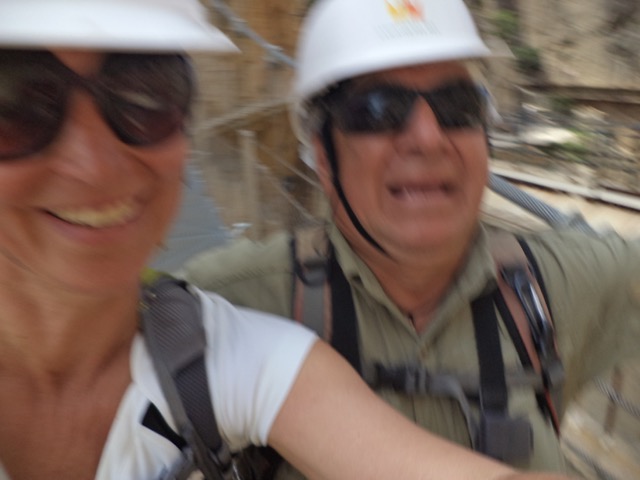 The path itself, going right above the narrow old cement path, is beyond words. It is really a thing one has to experience. Just before the end of the walkway is the piece de resistance, a steel suspension bridge crossing the gorge next to the rusty old aqueduct that the sure-footed climbers used. Hold onto your hat, no, actually forget about your hat and hold onto the steel railings, as the bridge will move. This too has a warning sign that no more than a dozen people should cross at a time, but who is counting… The path itself, going right above the narrow old cement path, is beyond words. It is really a thing one has to experience. Just before the end of the walkway is the piece de resistance, a steel suspension bridge crossing the gorge next to the rusty old aqueduct that the sure-footed climbers used. Hold onto your hat, no, actually forget about your hat and hold onto the steel railings, as the bridge will move. This too has a warning sign that no more than a dozen people should cross at a time, but who is counting…
During the first year the entrances were free. The site indicates that they charge 10 euros now, yet when I tried to book today, it said that the charge was 0 euros. It is probably advisable to call directly or to go with a guide. Anyhow, do not let these technicalities discourage you, as it is really worth the walk. Just check the weather before you go, as the path closes if it rains or is too windy for safe passage.
 Whether the king actually walked the entire span of the gorge or only stepped onto it for a photo-op and was quickly whisked back into his chauffeured car, we will probably never know. He is not the hero of this story or the one whose name should adorn the emblematic walkway. What struck me while crossing the gorge was the thought that this was not only the singular way for the workers of the hydroelectric plants to move from one dam location to another. It was also the only way for their families to get to the neighbouring village, crossing the boardwalk on foot, bicycle or horseback. Even the local children used the Caminito to get to school, walking on the narrow cement path with a single iron railing, some 100 meters above the gorge! To all of them the new boardwalk should be dedicated. Whether the king actually walked the entire span of the gorge or only stepped onto it for a photo-op and was quickly whisked back into his chauffeured car, we will probably never know. He is not the hero of this story or the one whose name should adorn the emblematic walkway. What struck me while crossing the gorge was the thought that this was not only the singular way for the workers of the hydroelectric plants to move from one dam location to another. It was also the only way for their families to get to the neighbouring village, crossing the boardwalk on foot, bicycle or horseback. Even the local children used the Caminito to get to school, walking on the narrow cement path with a single iron railing, some 100 meters above the gorge! To all of them the new boardwalk should be dedicated.
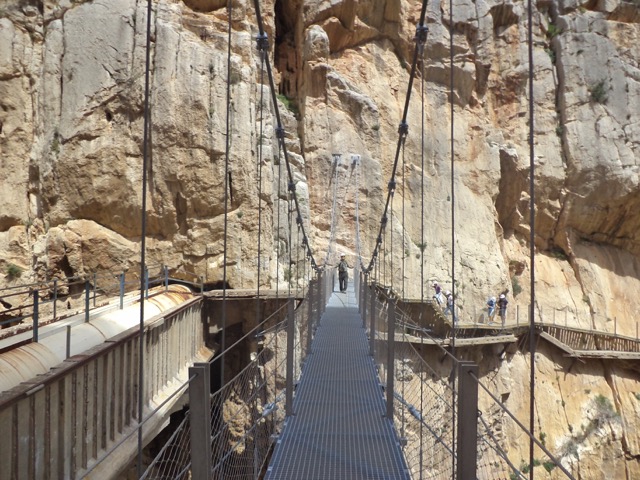
 3
Like
Published at 8:39 AM Comments (6)
3
Like
Published at 8:39 AM Comments (6)
How I finally became member of The Ladies of Ronda Dumpster Diving Society
Saturday, July 16, 2016
 I have to admit, I had become a great disappointment to the ladies of my furniture restoration class. Week after week I would come into the class empty handed. The other students would look at me with lifted plucked eyebrows, wondering why I would not bring old treasures from my grand casa (we had none…) or at the very least from the contenadores de basura. I tried to explain that I had seen a three-legged chair or a broken TV by the dumpsters, but nothing salvageable or worthy of restoration. I have to admit, I had become a great disappointment to the ladies of my furniture restoration class. Week after week I would come into the class empty handed. The other students would look at me with lifted plucked eyebrows, wondering why I would not bring old treasures from my grand casa (we had none…) or at the very least from the contenadores de basura. I tried to explain that I had seen a three-legged chair or a broken TV by the dumpsters, but nothing salvageable or worthy of restoration.
 Finding this foreigner both helpless and useless, in pure pity one of the women gave me a chair to work on. It had more bugs than wood, but underneath layers of paint and glossy varnish I found the most amazingly Art Nouveau embossed leatherwork. Finding this foreigner both helpless and useless, in pure pity one of the women gave me a chair to work on. It had more bugs than wood, but underneath layers of paint and glossy varnish I found the most amazingly Art Nouveau embossed leatherwork.
Weeks went by while I diligently worked on my chair. The Ladies of Ronda Dumpster Diving Society would gradually approach, inspecting my handiwork and sometimes offer me a different tool or suggest a different brush. Clearly, I was not one of them, but they had accepted that la extranjera, the first foreigner ever to take a class with them, was there to stay. My membership in the Ladies of Ronda Dumpster Diving Society was no longer suspended, though I was certainly not a card-holding member. Not yet…
One day, it all changed. Our neighbour Maria del Mar came hurrying into our class, calling me to come with her immediately. I followed her across the plaza, expecting to find a great emergency in our peaceful dead-end street. Instead, I found her aging mother, her adult son, two other neighbours and my husband waiting by the garbage containers. Communally, they had been guarding a truckload of furniture that someone had thrown out, making sure that I would get the first pick. You see, Thursday is when the city picks up unwanted furniture, so the Dumpster Diving Society goes into high gear on Wednesday night after dark right until Thursday morning
Each carrying an armchair, my husband and I walked back to the school. The seats were not Louis XIV, nor Andalucían antiques, but they seemed comfortable enough and, most importantly, they were found in the darn dumpster. The students cheered us on like soldiers coming back from battle. The oldest and most venerable lady in the Society took it upon herself to sit down in one of the chairs. She nodded her sign of approval. Yes, they were comfortable. Where had we found them and were there any more, another lady wanted to know. The class took off en masse, horn rimmed Dior glasses, paint-splattered lab coats, high heels and all. Moments later, they returned from the raid, one with a footstool, another with a mirror, and two carrying a bed frame.
We had found the mother load of all dumpster discoveries. And as far as la extranjera was concerned, I was finally accepted as a full-fledged member in The Ladies of Ronda Dumpster Diving Society.

 2
Like
Published at 6:19 PM Comments (0)
2
Like
Published at 6:19 PM Comments (0)
Waist high and nose deep in lavender
Friday, July 15, 2016
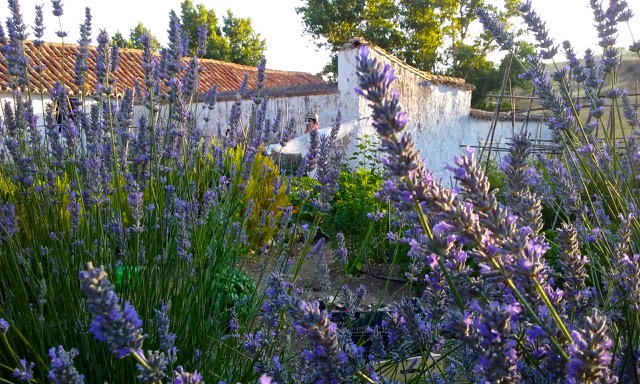 It is harvest time. That is to say, we are harvesting our lavender - all two plants of them. This may not seem like much, and it certainly wasn’t when we bought a couple of 1.50-euro pots three summers back. But things can certainly grow on these latitudes and the same plants are now giant bushes with a circumference of a couple of meters each. They might not be seen from space yet, but thanks to them, ours are decidedly the most eye-catching plot when you arrive at the community garden. It is harvest time. That is to say, we are harvesting our lavender - all two plants of them. This may not seem like much, and it certainly wasn’t when we bought a couple of 1.50-euro pots three summers back. But things can certainly grow on these latitudes and the same plants are now giant bushes with a circumference of a couple of meters each. They might not be seen from space yet, but thanks to them, ours are decidedly the most eye-catching plot when you arrive at the community garden.
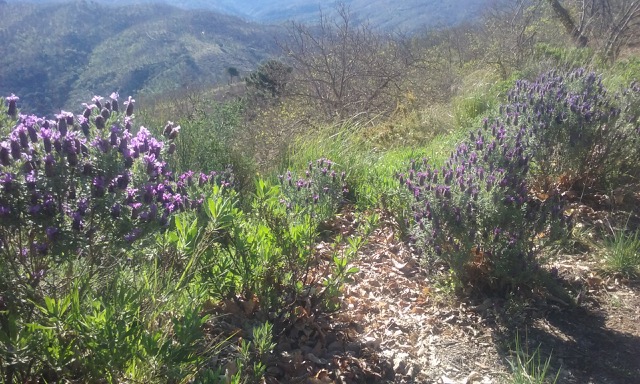 Say the world lavender and people immediately think lavender fields in Provence or English gardens. Yet lavender is not native to England and Bulgaria actually overtook France as the world's biggest producer of lavender oil in 2011. Spain might not be amongst the top contestants when it comes to actual production, but while France has three species and two hybrids of lavender, the Iberian Peninsula has eleven species and subspecies and four wild hybrids, and twice as many if one counts the Canary Islands. France is still vital for the entire lavender industry, certainly in quality, innovation and marketing. Historically speaking, the plant was an important ingredient in France’s perfume industry, even if the most fragrant lavender is not the French Lavendila Dententa, but the Spanish Lavendula Stoechus. Say the world lavender and people immediately think lavender fields in Provence or English gardens. Yet lavender is not native to England and Bulgaria actually overtook France as the world's biggest producer of lavender oil in 2011. Spain might not be amongst the top contestants when it comes to actual production, but while France has three species and two hybrids of lavender, the Iberian Peninsula has eleven species and subspecies and four wild hybrids, and twice as many if one counts the Canary Islands. France is still vital for the entire lavender industry, certainly in quality, innovation and marketing. Historically speaking, the plant was an important ingredient in France’s perfume industry, even if the most fragrant lavender is not the French Lavendila Dententa, but the Spanish Lavendula Stoechus.
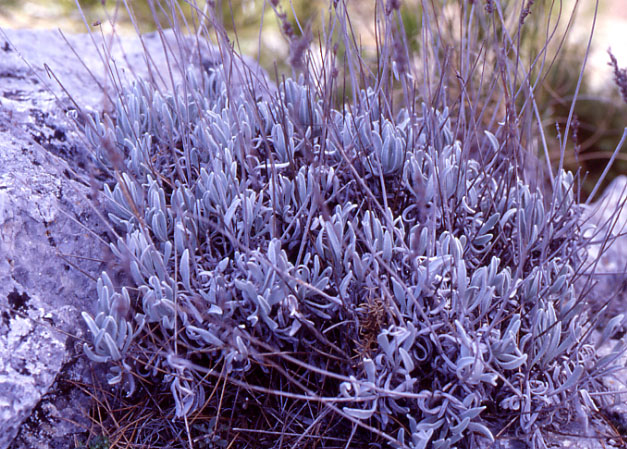 Originating in the coastal areas along the Mediterranean, lavender has been known for at least 2500 years and been acknowledged for its medicinal properties since the Materia Medica was written in the 1st century. There are now said to be some 115 varieties of the plant growing in gardens virtually all around the globe. When I was young nobody could ever imagine that lavender would grow in Norway, yet be it due to global warming or creation of tougher hybrids, one can now see lavender in Scandinavian gardens. I suppose soon we will see new hybrids of Alaskan and Icelandic lavender, as well? Lavender loves the Andalucian hot sun and poor soil. For us living here, the wild lavender is a common site along country roads and hiking trails, especially during the spring months when they are in bloom. There are times when one literally can walk waitst high in the deep purple blooms. Particularly the endemic species, such as the Lavandula Lantana, commonly known as Alhucema manage to grow from tiny gaps in the rock and be born out of the smallest patch of sandy soil. Originating in the coastal areas along the Mediterranean, lavender has been known for at least 2500 years and been acknowledged for its medicinal properties since the Materia Medica was written in the 1st century. There are now said to be some 115 varieties of the plant growing in gardens virtually all around the globe. When I was young nobody could ever imagine that lavender would grow in Norway, yet be it due to global warming or creation of tougher hybrids, one can now see lavender in Scandinavian gardens. I suppose soon we will see new hybrids of Alaskan and Icelandic lavender, as well? Lavender loves the Andalucian hot sun and poor soil. For us living here, the wild lavender is a common site along country roads and hiking trails, especially during the spring months when they are in bloom. There are times when one literally can walk waitst high in the deep purple blooms. Particularly the endemic species, such as the Lavandula Lantana, commonly known as Alhucema manage to grow from tiny gaps in the rock and be born out of the smallest patch of sandy soil.
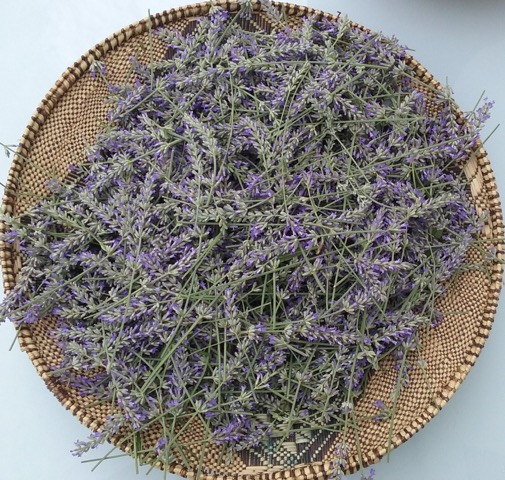 Lavender comes from the Latin word lavandula, derived from the Latin verb lavare, meaning to wash. It is said to be because the Romans used lavender amongst other things to scent their bathwater. The plant was used during many plagues to disinfect homes and hospitals or burned to keep away bad smells, which were thought to attracted diseases. Lavender comes from the Latin word lavandula, derived from the Latin verb lavare, meaning to wash. It is said to be because the Romans used lavender amongst other things to scent their bathwater. The plant was used during many plagues to disinfect homes and hospitals or burned to keep away bad smells, which were thought to attracted diseases.
So, what can you do with it with lavender, other than making sachets for your lingerie? Not only is it beautiful, but it has literally hundreds of uses. Lavender is antibacterial, antimicrobial, expectorant, stress relieving, antiseptic and analgesic, for those who know what all that means. Essential lavender oil can be used to protect against airborne viruses and bacteria, relieve menstrual cramps, deter moths & silverfish, calm coughs and colds, promote relaxation and sleep, sooth sunburns or other smaller burns, as a dandruff remedy, to relax sore muscles, for headaches, as a skin toner, for acne or skin irritations or as a natural air freshener. It can be used in baking, gourmet cooking, salads or teas. One can make lavender soaps, creams, talc, body butters, potions, lotions, bath bombs, scented oils, wreaths, candles, room sprays, carpet deodorizer or dryer sheets, just to mention a few.
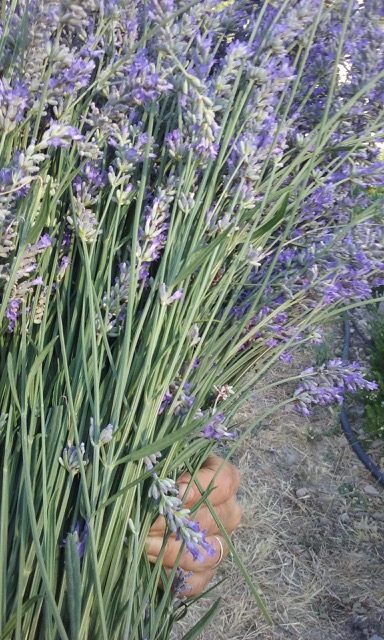 The lavender harvest should happen when the flowers are at their most stunning, or so my aunt who grows them in Tuscany told me. And aunts know such stuff. Other information sources tell one to pick them when 2/3 of the blooms are open, or was it 1/3? Anyhow, we pick a bit each day, cut off part of the stem and dry them in a large flat Zambian basket on the terrace, ideally away from direct sunlight. Once dried, you can easily pull the lavender flowers off the stem, going with the direction of the straw, or in stubborn cases, against it. Your hands will be black in the end, but will smell ever so lovely. The lavender harvest should happen when the flowers are at their most stunning, or so my aunt who grows them in Tuscany told me. And aunts know such stuff. Other information sources tell one to pick them when 2/3 of the blooms are open, or was it 1/3? Anyhow, we pick a bit each day, cut off part of the stem and dry them in a large flat Zambian basket on the terrace, ideally away from direct sunlight. Once dried, you can easily pull the lavender flowers off the stem, going with the direction of the straw, or in stubborn cases, against it. Your hands will be black in the end, but will smell ever so lovely.
If I understand right, the production ratio for lavender oil is 100/1, meaning 100 kilos of blooms to one kilo of oil, so I am not planning to become commercial lavender producer just yet…To me, the greatest joy of growing lavender is simply having them there. To walk along the plants, letting ones hand touch the top of the flowers to release its heavenly scent.
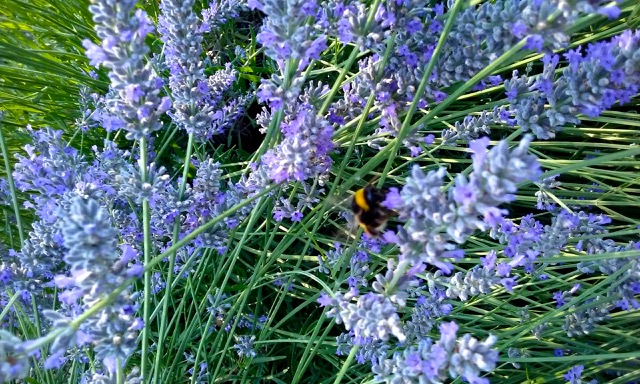 I never thought in my life I would virtually drown in lavender, but this is what I do these days, diving nose deep into the bushes, of course watching out for the other critters that also enjoy them. The bees, that most threatened species, love our huerto and all the flowering herbs there, lavender being their favourite. That should be reason enough to grow it, as heaven knows and we all know that the world needs more bees. The bees and I have come to a mutual understanding of shared enjoyment. I let them buzz about the plants and enjoy its bounty and they let me crop away, simply flying over to a different sprig to get out of the way. I never thought in my life I would virtually drown in lavender, but this is what I do these days, diving nose deep into the bushes, of course watching out for the other critters that also enjoy them. The bees, that most threatened species, love our huerto and all the flowering herbs there, lavender being their favourite. That should be reason enough to grow it, as heaven knows and we all know that the world needs more bees. The bees and I have come to a mutual understanding of shared enjoyment. I let them buzz about the plants and enjoy its bounty and they let me crop away, simply flying over to a different sprig to get out of the way.
Every day I harvest an armful, leaving a trail of scented straws as we climb up from our huerto, maybe surprising a neighbour or friend with a generous bouquet and filling every vase in the house with freshly cut blooms. There is enough for everybody, para dar y prestar. (To give away and lend) as they say here in Andalucia.
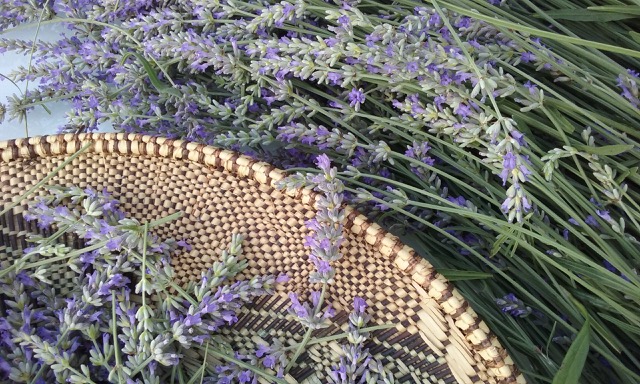
 2
Like
Published at 10:02 AM Comments (2)
2
Like
Published at 10:02 AM Comments (2)
What NOT to do to survive the Andalucían summer
Thursday, July 7, 2016
 No doubt about it, summer is here. The other day Sevilla reached 47 degrees Celsius and this is early July! Here in Ronda we are not far behind, so what does a Viking with low heat tolerance, a virtual heat wimp, do to survive the summers of Southern Spain? As I haven't figured out my DOs yet, let me tell you my DON’Ts: No doubt about it, summer is here. The other day Sevilla reached 47 degrees Celsius and this is early July! Here in Ronda we are not far behind, so what does a Viking with low heat tolerance, a virtual heat wimp, do to survive the summers of Southern Spain? As I haven't figured out my DOs yet, let me tell you my DON’Ts:

DON'T spend the day scraping paint off a door on the terrace
It seemed like a good idea at the time, working outside in the breeze and the shade, but that was before I almost perished by heat stroke. You see, the Andalucian rays get everywhere. It is like the wind that comes from all directions at the same time. Heat envelops you from above, below and from every possible angle in between. Even if the sun isn’t actually hitting the spot where you are standing, there is no escaping its wrath. Scraping paint was particularly unsuited to this type of weather, as millions of paint-pieces adhered to my damp skin like glue and not even a rough floor brush got them off. The stone flooring amplified the heat factor and the white walls blinded me, while I slowly sizzled alive.
 DON’T start baking DON’T start baking
We had an abundance of fresh zucchinis from our community garden and naturally I wanted to make sure they didn't go bad. Zucchini bread for the freezer was my bright Martha Stewart-inspired solution. I had finally accepted that one ought to stay inside in the heat of summer (see above), so I reasoned that baking would be a perfect mid-day summer indoor activity. You can see that I don't do much cooking… As the oven gradually got warmer, I realized that this might have been a bit of a mistake. Taking my ready masterpieces out of the oven made it even worse, with no place for the hot air to escape. Our entire house became an extended oven, making it unliveable not only for the Norwegian in the family, but even for the Mexican.

DON’T do yoga in the dark
I usually do yoga in the morning. As daylight emerges, I go down to our office where I can play my Eternal Ohm, spa-like muzak, Bollywood soundtracks or African rap, depending on how rebellious or ‘Zen’ I feel. Summer is my least ‘Zen’ time of the year, by far. As the temperature rises, I start my session earlier, to prevent the outer heat from interfering with my inner one. While there might be rodents and slithering guests coming into my hall of inner peace, I always open the window to the elements, to get my daily dose of fresh air. Fearing that the heat would make me see double before I go into my first shoulder stand, I decided to go down to my yoga session in the pitch black. Considerate as I am (after all, I am a yogi…) I did not want to awake the above-mentioned Mexican, so I left the lights off, risking life and limb as I fumbled my way down two flights of railing-less stairs. After crashing into undefined objects and stubbing my toe in transit, there was of course an ‘early bird’ fly there to greet my pre-sun salutations.
 DON’T open the windows DON’T open the windows
Like a true Viking, I believe that there is nothing better for ones health and wellbeing than fresh air. Actually, we Northerners solve almost any problem with AIR. Like the English run for a cup of tea when crisis hits, we get a bit of fresh air. Most of us keep windows open all year around, including the coldest winter nights. I mean, what could be healthier??? If there is a larger problem at hand, one might go for a brisk walk to air out ones head. With this preamble, it was only natural for me to think that the still air in our house in the midst of summer needed airing out, or a change of air, as it were. We had built our house with the traditional thick Andalucian walls, to keep the heat IN in the winter and OUT in the summer, but having a breeze running right through the house, albeit hot, felt like the right thing to do. In retrospect, I see why all our Spanish neighbours keep their windows closed and their blinds down all summer, even if the thermometer go down to a balmy 25 degrees at night. I suppose I just can forget about fresh air until October…
 DON’T go on a fly hunt DON’T go on a fly hunt
I am not sure if the flies around here are native to Andalucía or have travelled from further afield. They certainly are tough enough to survive a jeep-ride across the Sahara and crossing the Gibraltar Straight in a leaky dingy. Wherever they origin, what I can say is that they are a pesky breed, indeed.
Whether you air out the house or not, you will have flies. Whether you have screens on every window and barely open your front door a narrow gap to sneak out, mark my word you will have flies. If you do not have flies coming in, there will be flies that have hibernated since last year. And even if you got rid off every single recruit of last year’s army of flies, there will be thousands of eggs waiting to hatch in places your broom can never reach. Naturally it is tempting for a Scandinavian cleaning freak to try to eradicate these pests. I do not want to use carcinogenic bug sprays and I cannot stand the thought of an electric fly-zapper or a trap full of fly carcasses, so I vacuum them out. Well, I try. And I try. Surely the neighbours are talking about the mad foreigner who runs around with the vacuum, fighting invisible demons and screaming at what looks like an empty room. As the summer temperature rises, the flies get more and more clever and persistent, and I get more and more lethargic and sloth-like. I might have to admit that during the heat of summer the flies are a loosing battle, even for this Viking.
 DON’T get drunk DON’T get drunk
We all know that one is supposed to drink lots of fluids in the heat. And I do. My drink of choice in plus 30 degrees is usually water by the gallon. However, one night I joined some Spanish friends, most of whom with seemingly unlimited capacity for food and alcohol. I was served a glass of liquor-infused sangria. It was so effortless to drink, just like lemonade with a happy colour. Every time I looked away, like a cup of cornucopia, my glass was filled up to the rim again. As night fell and the heat started lightening its grasp on our throats, we all cheered. And cheer one certainly should, though preferably in water I realized as I was lying in bed, trying not to close my eyes to prevent the room from going around, something I have not done for decades. Blame the heat, blame the ever-filling glass or blame the lack of fresh air.
So, the moral of the story is… DO greet the day, but do it mindfully. DO air out the house, just not at high noon. And DO cheer at sunset, though preferably not in a fountain of sangria.

 2
Like
Published at 4:23 PM Comments (5)
2
Like
Published at 4:23 PM Comments (5)
Spam post or Abuse? Please let us know
|
|